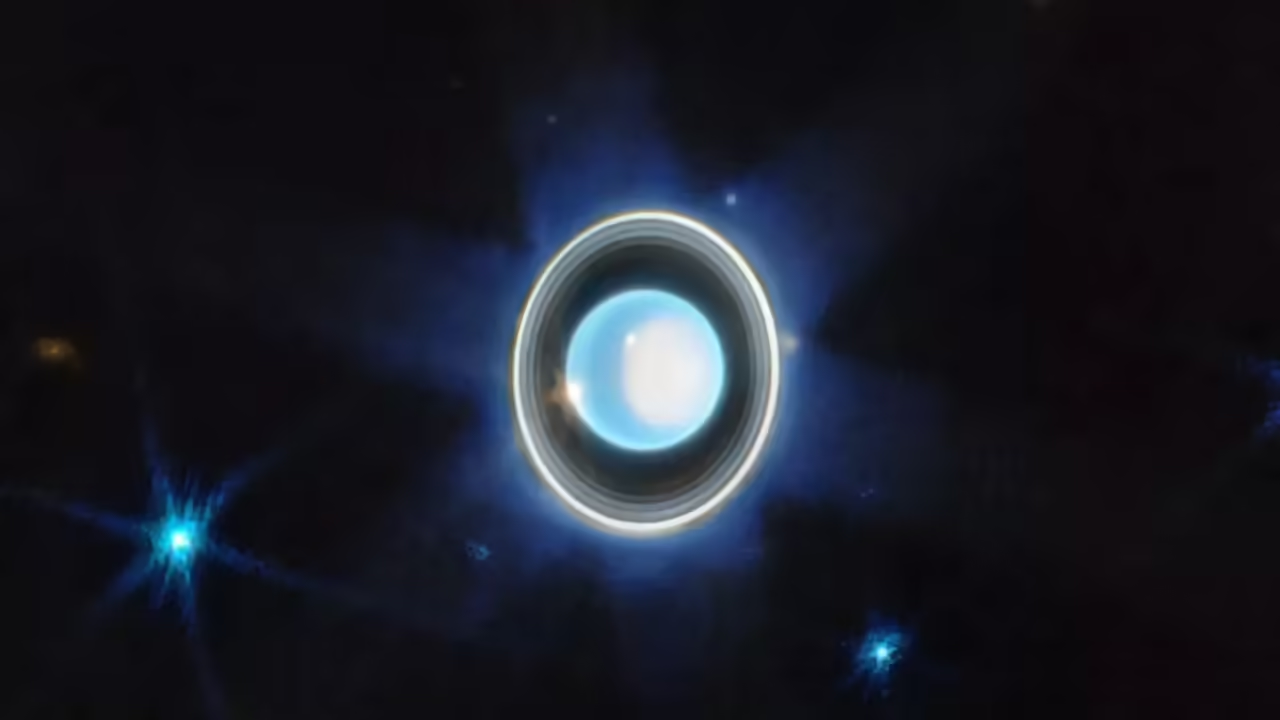
NASA has just released a stunning image of Uranus, captured by the James Webb Space Telescope. This image, which shows the planet in a perspective never seen before, has caused a great stir in the scientific community and the general public.
Uranus is one of the most mysterious and least understood planets in our solar system. It is an icy giant planet, composed mainly of hydrogen and helium, but also methane and other gases. It was discovered in 1781 by astronomer William Herschel, and has been studied by astronomers for centuries.
The new image of Uranus, captured by NASA’s James Webb Space Telescope, shows the planet in an unprecedented perspective. Clouds and storms in Uranus’ atmosphere can be seen in the image, as well as the unique tilt of its axis. The image is clear and detailed, which will allow scientists to study the planet in depth and better understand its composition and history.
Capturing this image was no easy task. Uranus is located at a distance of more than 3 billion kilometers from Earth, making it one of the farthest planets in our solar system. In addition, its position in the sky is constantly changing due to its unique axial tilt, making it difficult to capture in a clear image.
However, the James Webb Space Telescope has proven to be an exceptionally powerful instrument for observing distant planets such as Uranus. Equipped with a high-resolution camera and state-of-the-art technology, the telescope has enabled scientists to capture this stunning image and obtain valuable data about the planet’s atmosphere and composition.
The new image of Uranus is a testament to the power and potential of space technology to explore and understand our universe. It is a reminder that there is still much to discover and learn about the planets and other celestial objects around us. The capture of this image is an important milestone in space exploration, and there are surely more exciting discoveries and surprises to come.
The significance of Webb’s image of Uranus for science
The image of Uranus captured by NASA’s James Webb Space Telescope is a significant achievement for science, providing valuable data on the planet’s composition and atmosphere.
Uranus is one of the least explored and least understood planets in our solar system. Its composition and the formation of its atmosphere are a mystery to scientists, and the capture of this clear and detailed image offers a unique opportunity to study it in depth.
The image shows the clouds and storms in Uranus’ atmosphere, as well as the unique tilt of its axis. This axial tilt is particularly interesting to scientists, as it is the cause of extreme seasonal changes on the planet and has been a puzzle to astronomers for centuries.
The image also provides data on the composition of Uranus’ atmosphere. The presence of methane in the atmosphere is clearly visible in the image and this is important to scientists because methane is an important gas in the formation of Uranus’ atmosphere. In addition, the image allows scientists to study the characteristics of storms and cloud formation in the planet’s atmosphere.
The capture of this image is a testament to the James Webb Space Telescope’s ability to observe distant planets with unprecedented clarity. This is a major achievement for space technology and opens the door to further discoveries in space exploration.
How was Uranus imaged with the James Webb Space Telescope?
The image of Uranus was taken by NASA’s James Webb Space Telescope using its near-infrared imaging camera (NIRCam). The NIRCam camera is capable of imaging in the visible and near-infrared spectrum, allowing scientists to study celestial objects in detail.
To take the image of Uranus, the James Webb Space Telescope pointed its 6.5-meter-diameter main mirror at the planet and the NIRCam camera took images for several hours. The final image was processed by scientists to highlight the most important details, such as clouds and storms in Uranus’ atmosphere.
The James Webb Space Telescope was designed specifically for detailed astronomical observations of distant celestial objects. Its main mirror is the largest ever built for a space telescope and is capable of collecting more light than any previous space telescope. In addition, the telescope’s NIRCam camera is highly sensitive and can detect even faint objects in space.
What does Webb’s image of Uranus reveal about the planet and its atmosphere?
The image of Uranus captured by NASA’s James Webb Space Telescope reveals several interesting details about the planet and its atmosphere.
First, the image shows the unique tilt of Uranus’ axis, which is unlike that of any other planet in our solar system. This axial tilt is the cause of extreme seasonal changes on the planet, and the image clearly shows the north polar region of Uranus, which is plunged into darkness at this time due to the planet’s tilt.
The image also shows details in Uranus’ atmosphere, such as clouds and storms. Uranus’ clouds are composed mainly of methane and can extend up to altitudes of 300 km above the planet’s surface. The image also shows several storms in Uranus’ atmosphere, including a large storm in the southern region of the planet.
The image also shows the composition of Uranus’ atmosphere. Methane in the planet’s atmosphere absorbs red light and reflects blue light, giving Uranus its characteristic blue-green color. The presence of methane in the atmosphere is also important to scientists, as methane is an important gas in the formation of Uranus’ atmosphere.
Comparison of Webb’s image of Uranus with previous images of the planet
Compared to previous images of Uranus, captured by telescopes on Earth and by the Voyager 2 spacecraft in the 1980s, Webb’s image shows much higher quality and resolution. Webb’s image clearly shows details in Uranus’ atmosphere, including clouds and storms, that could not be seen in previous images.
Apart from the above, Webb’s image shows the unique axial tilt of Uranus and the northern polar region plunged in darkness, which cannot be seen in the previous images due to lack of resolution and clarity.
Webb’s work also provides valuable information about the chemical composition of Uranus’ atmosphere. The presence of methane in the planet’s atmosphere is clearly shown in Webb’s image, providing important information about the formation and evolution of Uranus’ atmosphere.
The difficulties of observing Uranus and how the Webb mission overcame them
Observing Uranus has historically been difficult because of the planet’s great distance, its small angular size in the sky, and its faint brightness compared to other, closer planets. On the other hand, Uranus’ atmosphere is characterized as turbulent and chaotic, making it difficult to accurately observe details on its surface.
However, NASA’s Webb mission has overcome many of these difficulties thanks to its unique features. First, the Webb space telescope is much larger and more powerful than any ground-based telescope, allowing unprecedented resolution and clarity in images of Uranus. In addition, the telescope is capable of detecting infrared wavelengths, allowing scientists to study the atmosphere of Uranus in greater detail.
Another advantage of the Webb mission is its ability to observe Uranus from space, which eliminates atmospheric distortions that affect observations from Earth. In addition, the telescope is designed to be highly stable and to reduce vibrations, which further improves the quality of the images of Uranus.
The Webb mission has overcome the difficulty of Uranus’ unique axial tilt by observing the planet from different angles and positions in its orbit, allowing scientists to get a complete view of its atmosphere and surface.
Similarities and differences between Uranus and other giant planets in the solar system
In our solar system, there are four giant planets: Jupiter, Saturn, Uranus and Neptune. Each of them has unique characteristics, but they also share some similarities and differences with each other.
One of the most striking similarities among these planets is their size and composition. They are all gas planets, meaning that they do not have a solid surface and are composed primarily of hydrogen and helium. In addition, all the giant planets have rings, although those of Uranus are fainter and less visible than those of Jupiter or Saturn.
However, Uranus has some notable differences from the other giant planets. For example, it is the farthest planet from the Sun and has the smallest mass and size of the four. Also, unlike the other giant planets, Uranus has a unique axial tilt, which means that its axis of rotation is almost in the same plane as its orbit around the Sun. This unique axial tilt produces extreme seasons and a unique wind pattern in the planet’s atmosphere.
Another notable difference is that Uranus emits very little internal heat compared to the other giant planets. This is because the planet formed farther from the Sun, where conditions were cooler, and could not accumulate as much internal heat over time.
The international collaboration behind the Webb mission and the imaging of Uranus
The Webb mission is the result of an international collaboration between NASA, the European Space Agency (ESA) and the Canadian Space Agency (CSA). This mission has involved thousands of people from around the world, including scientists, engineers, technicians and other specialists.
The James Webb Space Telescope was built by Northrop Grumman in collaboration with NASA, ESA and ASC. In addition, numerous academic and scientific institutions around the world have contributed key scientific instruments and technologies for the mission.
Capturing the image of Uranus with the James Webb Space Telescope was also made possible by international collaboration. The planning and execution of the observation required the coordination of multiple teams at different locations around the world.
The Webb team worked closely with teams of scientists who had obtained previous observations of Uranus with other telescopes in order to obtain a complementary and more detailed image. It also required collaboration with teams that had developed atmospheric models of the planet in order to better understand the features and patterns observed in the image.
International collaboration has been essential to the interpretation of Webb’s image of Uranus and the conduct of further scientific investigations. The data collected by the space telescope have been shared with scientists and research teams around the world, leading to significant advances in our knowledge of the planet.







